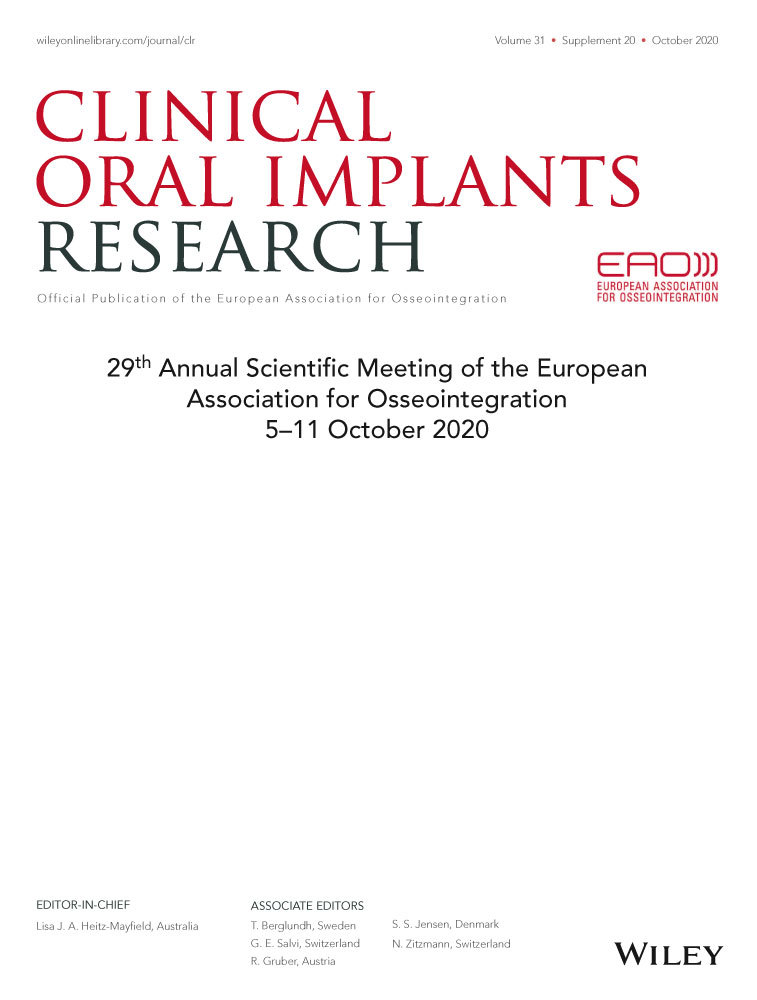Five years prosthetic outcome of a mandibular 2-implant overdenture on stud abutment
W7LQB ePOSTER CLINICAL RESEARCH – PROSTHETICS
Background: A 2-implant overdenture (2IOD) is a satisfying solution for the edentulous patient. Although the implant survival and the reported patient oral health related quality of life (OHRQol) is good, the maintenance of the overdenture in a longer term perspective is an important issue given population ageing. This maintenance need can be a decisive factor in the treatment planning.
Aim/Hypothesis: The first aim of the study was to describe the OHRQoL (OHIP-14) and to inventory the 5 years maintenance of Locator Legacy (LL) (Locator, Zest Anchors LLC, Escondido UAS) 2IOD. The second was to analyse this maintenance need in relation to mandibular jaw resorption and the patient related outcome.
Materials and Methods: Edentulous patients needing new dentures were informed about overdenture therapy and the study. They were split in 2 groups based on the Cawood and Howel (CAW-H) classification: Group 1 (CAW-H) III & IV with average bone height or width and Group 2 (CAW-H) V with low mandibular bone height. The participants received new CD serving as reference for CBCT and insertion of 2 OsseoSpeed dental implants (Astra Tech Implant System, Dentsply Sirona Implants) in the mandible. Post-surgery, the mandibular denture was adjusted with a resilient liner. After 3 months, functional connection with the (LL) abutments on the implants was done by the rebasing technique. At different moments (intake, 1Y, 2Y, 3Y, 4Y, 5Y) the patient reported outcome was assessed with the OHIP-14 questionnaire. All prosthetic interventions (repair, rebasing, retention caps…) were inventoried up to 5 years post connection. The prosthetic maintenance was analysed in relation to the resorption profile of the mandible.
Results: In 26 participants (13 f, 13 m, mean age 66) 52 implants were placed. Group 1 consisted of 15 and group 2 of 11 participants. The implant survival after 5 years was 100%. The conversion to 2IOD significantly improved the OHRQoL with OHIP-14 total score decreasing from 15.2 at intake to 3.4 1Y post connection (P < 0.001) and remained stable up to 5 years (P < 0.001). Five years prosthetic maintenance resulted in, on average per patient, 5.5 retention caps, 2.2 upper denture interventions (repair, rebasing, new) and 0.7 IOD interventions (repair, remounting, new). Fifty percent of the LL abutments showed signs of wear. No rebasings were needed for the mandibular overdenture. Two patients in Group 1 needed a new upper denture or a new upper and lower IOD. The sum of the repairs (upper and lower) was significantly (P = 0.03) more prominent in group (CAW-H) III & IV and a similar result was obtained for the retention caps (P = 0.04).The maintenance had no impact on the patient reported outcome
Conclusions and Clinical Implications: The 2IOD on LL abutment improves the OHRQoL in a longer time perspective. Prosthetic maintenance including the change of retention caps, is unavoidable and more prominent in patients with less resorbed mandibles, without weighing on patient satisfaction.
Keywords: Overdenture mandible, Oral Health Related Quality of Life, Prosthetic maintenance, Mandibular resorption profile




